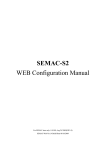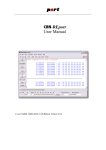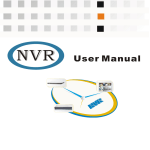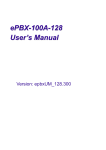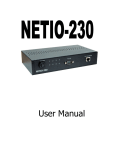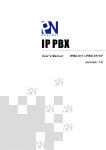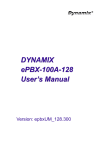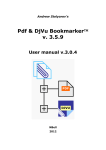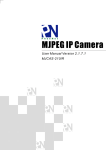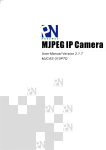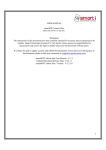Download ICA-302 User`s manual
Transcript
IR Internet Camera ICA-302 User’s Manual Copyright Copyright (C) 2006 PLANET Technology Corp. All rights reserved. The products and programs described in this User’s Manual are licensed products of PLANET Technology, This User’s Manual contains proprietary information protected by copyright, and this User’s Manual and all accompanying hardware, software, and documentation are copyrighted. No part of this User’s Manual may be copied, photocopied, reproduced, translated, or reduced to any electronic medium or machine-readable form by any means by electronic or mechanical. Including photocopying, recording, or information storage and retrieval systems, for any purpose other than the purchaser's personal use, and without the prior express written permission of PLANET Technology. Disclaimer PLANET Technology does not warrant that the hardware will work properly in all environments and applications, and makes no warranty and representation, either implied or expressed, with respect to the quality, performance, merchantability, or fitness for a particular purpose. PLANET has made every effort to ensure that this User’s Manual is accurate; PLANET disclaims liability for any inaccuracies or omissions that may have occurred. Information in this User’s Manual is subject to change without notice and does not represent a commitment on the part of PLANET. PLANET assumes no responsibility for any inaccuracies that may be contained in this User’s Manual. PLANET makes no commitment to update or keep current the information in this User’s Manual, and reserves the right to make improvements to this User’s Manual and/or to the products described in this User’s Manual, at any time without notice. If you find information in this manual that is incorrect, misleading, or incomplete, we would appreciate your comments and suggestions. CE mark Warning The is a class B device, In a domestic environment, this product may cause radio interference, in which case the user may be required to take adequate measures. WEEE Notice To avoid the potential effects on the environment and human health as a result of the presence of hazardous substances in electrical and electronic equipment, end users of electrical and electronic equipment should understand the meaning of the crossed-out wheeled bin symbol. Do not dispose of WEEE as unsorted municipal waste and have to collect such WEEE separately. Trademarks The PLANET logo is a trademark of PLANET Technology. This documentation may refer to numerous hardware and software products by their trade names. In most, if not all cases, their respective companies claim these designations as trademarks or registered trademarks. Revision User’s Manual for PLANET Infrared Internet camera Model: ICA-302 Revision 1.0 Part No. EM-ICA302V1 Table of Contents CHAPTER 1 INTRODUCTION.............................................................................................. 1 Overview ............................................................................................................................ 1 Physical Details .................................................................................................................. 3 Package Contents .............................................................................................................. 4 CHAPTER 2 BASIC SETUP ................................................................................................... 5 System Requirements........................................................................................................ 5 Installation ......................................................................................................................... 5 Setup ................................................................................................................................... 6 CHAPTER 3 ADVANCED VIEWING SETUP ................................................................... 10 Introduction ..................................................................................................................... 10 Adjusting the Video Image ............................................................................................. 10 Controlling User Access to the Video Stream ............................................................... 13 Making Video available from the Internet.................................................................... 14 CHAPTER 4 WEB-BASED MANAGEMENT .................................................................... 18 Introduction ..................................................................................................................... 18 Connecting to ICA-302.................................................................................................... 18 Welcome Screen............................................................................................................... 19 Viewing Area ................................................................................................................... 20 Control Panel Screen....................................................................................................... 21 Advanced Functions Area............................................................................................... 22 Camera setting Menu ...................................................................................................... 22 System Screen .................................................................................................................. 23 Camera Screen................................................................................................................. 25 Network Screen................................................................................................................ 27 User Screen ...................................................................................................................... 31 IP Filter Screen................................................................................................................ 31 FTP Client Screen ........................................................................................................... 33 SMTP Screen ................................................................................................................... 35 Schedule Setting Screen .................................................................................................. 36 Motion Detection Screen................................................................................................. 36 Time Setting Screen......................................................................................................... 38 Popup Screen ................................................................................................................... 39 Firmware upgrade Screen .............................................................................................. 40 Factory Default Screen.................................................................................................... 42 Reboot............................................................................................................................... 42 ActiveX Control............................................................................................................... 44 CHAPTER 5 CLIENT UTILITY .......................................................................................... 54 INSTALLATION ............................................................................................................ 54 HOW TO USE ................................................................................................................. 58 APPENDIX A TROUBLESHOOTING ................................................................................ 73 Appendix A Troubleshooting ......................................................................................... 73 APPENDIX B BANDWIDTH CALCULATION ................................................................. 76 Appendix B: Bandwidth Calculation............................................................................. 76 APPENDIX C SPECIFICATIONS........................................................................................ 77 Appendix C: Specifications............................................................................................. 77 TCP/IP, HTTP, SMTP, FTP, NTP, DNS, DDNS, ARP, DHCP, PPPOE ................................. 78 Chapter 1 Introduction 1 This Chapter provides details of the ICA-302's features, components and capabilities. Overview This ICA-302 IR Network Camera is an inexpensive fully scalable surveillance technology. Because the Network Cameras can be plugged in to your existing computer network infrastructure, you will potentially save thousands of dollars on unnecessary cabling. By using IR technology, this Network Camera is not only working on day but also on night. The ICA-302 is accessible via the Internet connection. Connect your ICA-302 directly to a computer network or DSL modem, and with a standard Web browser you get instant, on demand video streams. Within minutes you can set up the Network Camera to capture a video image to a PC. Live video images can be uploaded to a website to see on condition that network is available. Network Camera applications Features • Ease to use Plug-N-Watch capability to simplify system integration in an existing network environment. • Greater image quality in day and night with longer life span ICA-302 can be deployed in many different situations, such as library, train station or factory production line to provide efficient, human-resource reducing, and offers flexibility, affordability, and reliability for the proper surveillance of manufacturing facilities. 1 • 20M IR distance The effective range could be 20 -25 meters. • Multi-Platform support Supporting TCP/IP networking, SMTP e-mail, FTP uploading and HTTP public network standards, ICA-302 can be applied and utilized to a mixed IP network environment. • Motion Detection This feature will send you alert message when motion is detected. The ICA-302 will compare consecutive frames to detect changes caused by the movement of large objects. • High quality video compression ICA-302 delivers complete, high quality images in JPEG format, which can be viewed using standard web browser. Internet Features • User-definable administration port number. This allows Internet Gateways to use “port mapping” so the ICA-302 and a Web Server can share the same Internet IP address. • DDNS Support In order to view video over Internet, user must know the Internet IP address of the gateway used by ICA-302. An easy-to-remember DDNS (Dynamic DNS) name will help you memorize your site more easily. • NTP (Network-Time-Protocol) Support NTP allows the ICA-302 to calibrate its internal clock from an Internet TimeServer. This ensures that the time stamp on the recorded video from the ICA-302 will be correct. Security Features • User Authentication If desired, the camera access can be restricted to known users. Users will have to enter their username and password before being able to view the video stream. Up to 10 users can be entered. • IP Filter The camera access not only can be restricted by username/password, but also can be limited by the IP range to bring users more security. Application • • Remote monitoring via Web browser Powerful central management software – Cam View 2 Physical Details ICA-302 Rear Panel Rear Panel Network Cable RJ-45 RS-485 Composite Video Output (BNC connector) Electric Plug This Ethernet port can detect or negotiate the transmission speed of the network automatically. Please use Category 5 “straight through” cable to connect the Network Camera to a 100Mbps Fast Ethernet network switch or hub. To connect to an indoor/outdoor Pan/Tilt scanner unit. Red: D- , Blue: D+ Use BNC video cable to connect the Network Camera with a TV monitor. The power is 12V DC. Please use the attached power adapter only. Otherwise, the improper power adapter may damage the Network Camera. 3 Package Contents The following items should be included: If any of these items are damaged or missing, please contact your dealer immediately. • PLANET ICA-302 Camera x 1 • Wall mount x 1 • Installation software and manual CD x 1 • Quick installation guide x 1 4 Chapter 2 Basic Setup 2 This Chapter provides details of installing and configuring the ICA-302. System Requirements • To use the LAN interface, a standard 10/100BaseT hub or switch is required. • System Requirement for viewer: System Hardware L Hint • Microsoft Internet Explorer 5.0 or later • VGA Monitor resolution 1024 x 768 (for Master Vision) • Pentium III 800MHz or above • Memory Size: 128MB or above • VGA card resolution: 800x600 or above • Windows 2000, XP Note: The listed information is minimum system requirements only. Actual requirement will vary depending on the nature of your environment. Installation STEP 1. Install the ICA-302 camera to a desired location STEP 2. Plug-in Network Cable into a network device, ex: hub / switch. STEP 3. Connect power adapter to provided power cable then to power socket. STEP 4. If you need to control additional RS-485 device; connect RS485 two wires to RS485, Red: D- , Blue: D+ STEP 5. If required, connect video BNC connector to local TV or monitor for displaing. 5 Setup Initial setup can be performed either from the web browser or using the supplied IPEditV3 utility. This utility can locate the ICA-302 even if its IP address is invalid for your network. You can then configure the ICA-302 with appropriate TCP/IP settings for your LAN. Subsequent administration can be performed with your Web browser, as explained in Chapter 4 - Web-based Administration. Setup Procedure Before setup operations The ICA-302 provides GUI (Web based, Graphical User Interface) for machine management and maintenance. L Note Current firmware supports Microsoft Internet Explorer, the Netscape Navigator support is planned in the future firmware release 1. Default LAN interface IP address of ICA-302 is 192.168.0.20. Setup the monitoring PC network within this same segment 192.168.0.xx. You may now open your web browser, and insert http://192.168.0.20 in the address bar of your web browser to logon ICA-302 web configuration page. 2. ICA-302 will prompt for User Name and Password, please enter admin as username and leave blank for password to continue machine Web Management. 3. The IE Web Page will display the “Security Warning” window, select “Yes” to install and run the ActiveX control into your PC if you first time use this camera. 6 4. After the ActiveX control was installed and ran, the main screen will be displayed. 5. Now, you login to the Network Camera as a full-authorized administrator. You can enter “Setting” to change the password and setup “Administrator” or “User” authority. Please refer to “Setting” Î “User” and “IP Filter”. 7 IPEditV3 Utility Or you may execute IPEditV3 to discover/edit IP address of ICA-302. Procedures of IPEdit utility • Please find the IPEditV3.exe in the Utility folder on user’s manual CD • Execute the IPEditV3.exe • Choose the target camera, the IP address and device name can be modified. • After modifications, you may now connect the camera via web browser. Or using the default IP address. Setup ActiveX to use the ICA-302 The ICA-302 web page communicates machine via ActiveX control. The ActiveX control must be downloaded from ICA-302 and installed on your PC. Your Internet Explorer security settings must allow for the web page to work correctly. To use the Network Camera, user must setup his IE browser as follows: From your IE browse Î ”Tools” Î ”Internet Options…” Î ”Security” ΔCustom Level…”, please setup your “Settings” as follow. Set the first 3 items • Download the signed ActiveX controls to Prompt • Download the unsigned ActiveX controls to Prompt • Initialize and script the ActiveX controls not masked as safe to Prompt 8 By now, you have finished your entire PC configuration for Network Camera. 9 Chapter 3 Advanced Viewing Setup 3 This Chapter provides information about the optional settings and features for viewing video via the Web browser. This Chapter is for Administrators only. Introduction After finishing the network setup, the ICA-302 can immediately be used by all users on your LAN. This chapter describes some additional settings and options for viewing live video: • Adjusting the video image • Controlling user access to the live video stream • Making video available from the Internet Adjusting the Video Image If necessary, the ICA-302 administrator can adjust the video image. Settings are provided for: • Image size - Select the desired size. The larger sizes require greater bandwidth. • Image quality - This determines the degree of compression applied to the Video stream. Higher quality requires greater bandwidth. • Saturation, Sharpness, Contrast, Hue adjustment To Adjust the Video Image: 1. Connect to the ICA-302 via Internet Explorer. 2. On the Setting menu, select Camera. You will see a screen like the example below. 10 Camera setting 3. Make the required adjustments, as explained below, and save your changes. Camera Setting PTZ Type Camera PT Image Size ICA-302 can connect with external scanner to control PT through RS485 bus. There are some protocols supported and will add more models in gradually. User can control the direction of Pan and Tilt. Reverse Pan: Check this option to reverse pan direction. Reverse Tilt: Check this option to reverse tilt direction. Select the desired video resolution. The default resolution is set to 320*240. Available resolution: ‧176x144‧320x240‧352x288 ‧ 640x480 11 Image Quality Select the desired image quality. The default Image Quality is set to Standard. Available selection: • Clarity: Video is better but frame rate may be slower • Fluency: Video is not as good as Clarity but frame rate may be higher • Default: System default value. Note: Higher image quality requires more bandwidth. Image, Mirror, Focus Mode, White Balance Mode, Exposure Mode These function buttons are reserved for PTZ model. It’s not functional in ICA-302. Saturation, Sharpness, Contrast, Hue Image quality adjustment, the parameter ranges from 0 to 255 Options Audio, Camera tour These functions are not available for this model. Reset to default If this option is enabled, all the settings in this page will be reset to factory default values. L Note Please check the appendix A for more information on the image adjustment. 12 Controlling User Access to the Video Stream By default, only system administrators can connect to the ICA-302 and view live video. If desired, you may apply the access privileges to known users, by requiring each user to login to the ICA-302 with their individual username and password. To Enable this feature: 1. Connect to the Web-based interface of the ICA-302. (Please check related chapters for details.) 2. In machine Setting menu, select User. 3. You may add up to 10 users in machine database, choose the user number, and enter the name, password and access right for each user. User Setting Screen Operation • The username of “Administrator” is fixed as “admin”. User can modify the password of “Administrator”. • When each user connects, they will be prompted for their username and password. They must enter the name and password defined on the User screen above. • The camera system administrator can have full access/system modification privileges; the user only has viewing privilege. 13 Making Video available from the Internet If your LAN is connected to the Internet, typically by a Broadband Gateway/Router and Broadband modem, you can make the ICA-302 available via the Internet. ICA-302 Setup The ICA-302 configuration does NOT need to change, unless: • You wish to change the port number from the default value (1024). • You wish to use the DDNS (Dynamic DNS) feature of the ICA-302. Second HTTP Port Configuration Normally, HTTP (Web) connections use port 80. Since the ICA-302 uses HTTP, but port 80 is likely to be used by a Web Server, you can use a different port for the ICA302. This port is called the "HTTP Port2". (The first port is port 80.) The HTTP port2 is disabled in default settings. If you prefer to use a different port number than port 80, you can specify the port number on the ICA-302's Network screen, as shown below. Network Screen The Network screen is part of the Web-based Administration interface. See Chapter 4 Web-based Management for further details on using this function. L Hint Viewers need to know this port number in order to connect and view live video, so the current communication port number has to be informed to the remote users to connect to. 14 DDNS (Dynamic DNS) Many Internet connections use a "Dynamic IP address", where the Internet IP address is allocated whenever the Internet connection is established. This means that other Internet users don't know the IP address, so can't establish a connection. DDNS is designed to solve this problem, by allowing users to connect to your LAN using a domain name, rather than an IP address. To use DDNS: 1. Register for the DDNS service with a supported DDNS service provider. You can then apply for, and be allocated, a Domain Name. 2. Enter and save the correct DDNS settings on the DDNS Setting screen in the Network setting menu. 3. Operation is then automatic: • The ICA-302 will then automatically contact the DDNS server whenever it detects that the Internet IP address has changed, and inform the DDNS server of the new IP address. • Internet users can then connect to your LAN using the Domain Name allocated by the DDNS service provider. • Limitation: if the ICA-302 is installed with private IP address behind the NAT router, please find and enable the DDNS feature on the router. This can prevent the remote users from not be able to connect to the camera. • Current supported DDNS service provider: www.dyndns.org , www.no-ip.com DDNS Setting Screen Router/Gateway Setup for remote viewing Your Router or Gateway must be configured to pass incoming TCP (HTTP) connections (from remote viewers) to the ICA-302. The Router/Gateway uses the Port Number to determine which incoming connections are intended for the ICA-302. This feature is normally called Port Forwarding or Virtual Servers in the router. The Port Forwarding/Virtual Server entry tells the Router/Gateway that incoming TCP 15 connections should be passed to the ICA-302. If necessary, check the user manual for your Router/Gateway for further details. L Hint The "Port" for the Port Forwarding / Virtual Server entry above is the “HTTP Port2" number specified on the Network screen of the ICA-302. Viewing via the Internet Clients (viewers) will need a broadband connection for viewing the camera; dial-up connections are not recommended for the online video display. Using your Web Browser If using your Web browser, you need to know the address of the camera (either the Internet IP address or the Domain name) and the correct communication port number. Enter the address of the ICA-302 and its port number, in the Address (or Location) field of your Browser. Example - IP address: HTTP://203.70.249.52:1024 Where the Router/Gateway's Internet IP address is 203.70.212.52 and the "HTTP Port2" number on the ICA-302 is 1024. Example - Domain Name: HTTP://ica302.dyndns.org: 1024 Where the Router/Gateway's Domain name is ica302.dyndns.org and the " HTTP Port2" number on the ICA-302 is 1024. Using the Windows Viewing/Recording Utility If using the CamView Utility, the details of the ICA-302 must be entered on the Internet tab of the Add Camera screen. 16 CamView - Add Camera Screen You can then select the camera in the Cameras list on the main screen, and click OK to establish a connection and view live video. Please check respective chapter for further details of viewing Video using either the Windows Viewing/Recording utility or Web Browser. 17 Chapter 4 Web-based Management 4 This Chapter provides Setup details of the ICA-302’s Web-based Interface. This Chapter is for Administrators only. Introduction The ICA-302 can be configured using your Web Browser. This must have an IP address, which is compatible with your PC. Connecting to ICA-302 • Use the following procedure to establish a connection from your PC to the ICA302 • Once connected, you can add the ICA-302 to your Browser's Favorites or Bookmarks. Connecting using your Web Browser 1. Start your web browser. 2. In the Address box, enter "HTTP://" and the IP Address of the ICA-302, 3. Example for default setting: HTTP://192.168.0.20 4. Default username/password for machine login: admin/ <no password> 5. If the Administrator ID and Password have been assigned, enter the name and password you assigned. 18 Welcome Screen When you connect, the camera Home screen will be displayed. The Home screen can be divided into three areas: • Viewing Area - Images from the Network Camera • Control Panel Area - Network Camera Manipulation and image quality control • Advanced Functions area - only available for administrator. Camera administrator can have full configuration in this menu. These options are explained in the following sections. 19 Viewing Area This welcome screen is displayed when you log in machine Viewing Area Screen • The ICA-302 web page requires ActiveX control to display the video content. The ActiveX control must be downloaded from the camera and installed on your PC. • The security settings on the Internet Explorer must allow the ActiveX plug in to be functional. Please refer to the chapter 2 Basic Setup. • After the ActiveX installation completed, video content will start playing automatically. Due to various network conditions, the video display may be a delay of a few seconds while the video stream is buffered. 20 Control Panel Screen When you connect, the camera control panel screen will be displayed. Camera direction Up, Down, Left, Right, Home Camera moving speed adjustment (If using external scanner) Adjust camera focus Recall/Preset Mode Camera Preset/Recall positions Frame rate adjustment via image quality Video Resolution Video Brightness adjustment positions Audio feature On/Off Camera Control Panel Screen The function on the control panel can be shown below: Button Camera Direction Camera Speed Recall/Preset mode Video Resolution Preset or Recall positions Video Brightness Definition Control camera up/down/left/right and home position Increase/decrease the camera Pan/Tilt speed Preset: set up camera fixed locations before operation Recall: Set camera position to preset location Adjust Video resolution The ICA-500 provides 4 resolutions: 640x480, 352x288, 320x240, 176x144 For NTSC camera: 320x240 is suitable For PAL camera: 352x288 and 176x144 are suitable However, all resolution are available for NTSC and PAL camera Preset or Recall camera 1~16 location(s) Ex. If you press 5, then the camera will move to preset location 5. Adjust Camera video brightness 21 Adjustment Image quality Adjust image quality. Clarity: Video is better but frame rate may be slower Fluency: Video is not as good as Clarity but frame rate may be higher Standard: System default value Frame rate adjustment directly Adjust video frame rate via giving a number directly. 1, 5, 10, 15, 20, 25, 30 Audio On/Off Turn on/off audio output function. Note: The Microphone is located on the rear panel. You need to position the MIC hole face to the audio source to have better audio quality. Advanced Functions Area The Advanced Functions menu offers more features and camera control privileges to meet various application demands. Note: Only available for administrator Advanced Functions Screen Three categories are contained: System Configuration (Basic Setting , Application) Setting Trigger Send out current message or setup activities Capture Capture current screen and save to HDD or other media Camera setting Menu Clicking on Setting on the menu provides privileges to all the settings for the ICA-302. The Setting menu is divided into 2 categories: Basic and Application settings: The Basic menu provides essential configurations of the ICA-302, and the Application menu is provided for various applications. Click on each button to display its setting page. 22 Basic Setting Parameters in the Basic configuration menu provide machine adjustment; the available configurations are listed below: Basic Setting Symbol Item Action System Define Frame Rate, camera name and view system log file. Camera Adjust camera parameters. Network Configure Network setting such as DHCP On/Off, DDNS and PPPoE User Setup user name, password and login privilege. IP Filter Setup legal IP address of user login (This function should be used with function “User” altogether) System Screen Click on the System menu, you will see a screen like the example below. System Screen System Settings System ID Product serial number 23 Camera Name This displays the name for the ICA-302; camera name is useful while multiple units are used. Default frame rate The default frame rate in ICA-302 is 30fps, the video frame rate can be adjusted in this menu or on the Control panel menu Log Administrator can check the log information in machine, including the Main Info, Appended Info, Operator IP, Operator MAC, and Time. Select the “View” button to check the log file. Log Screen 24 Camera Screen Click on the Camera menu, you will see a screen like the example below Note: please adjust carefully to have proper machine configurations. Camera Screen Data - Camera Screen Camera Setting PTZ Type Camera PT Image Size ICA-302 can connect with external scanner to control PT through RS485 bus. There are some protocols supported and will add more models gradually. User can control the direction of Pan and Tilt. Reverse Pan: Check this option to reverse pan direction. Reverse Tilt: Check this option to reverse tilt direction. Select the desired video resolution. The default resolution is set to 320*240. Available resolution: ‧176x144‧320x240‧352x288 ‧ 640x480 25 Image Quality Select the desired image quality. The default Image Quality is set to Standard. Available selection: • Clarity: Video is better but frame rate may be slower • Fluency: Video is not as good as Clarity but frame rate may be higher • Default: System default value. Note: Higher image quality requires more bandwidth. Image, Mirror, Focus Mode, White Balance Mode, Exposure Mode These functions are available for PTZ Network Camera only. It’s not functional for this model. Saturation, Sharpness, Contrast, Hue Image quality adjustment, the parameter ranges from 0 to 255 Options Audio, Camera tour These functions are not available for ICA-302. Reset to default If this option is enabled, all the settings in this page will be reset to factory default values. 26 Network Screen You may configure Network setting such as IP address, DHCP, DDNS and PPPoE in the Network setting page. Network screen Data - Network Screen Network Settings DHCP “DHCP OFF” is default network setting of the Network Camera, if users choose “DHCP ON” when a ICA-302 is joined into the LAN, it will issue the DHCP packets to request an IP address that is dynamically assigned by the DHCP server. If it can not get a DHCP address on a limited tries, the ICA-302 will assigned a default IP address as the default IP address. IP address, Subnet mask, Default gateway, Primary DNS, Secondary DNS These parameters allow users to setup the IP address assigned by ISP. Your ISP should provide all the information requied for Internet access. HTTP Port 1, HTTP Port 2 Users could assign the port number of http protocol, and the WAN users should follow the port number to login. Note: User need to reboot the IC-302 to make this setting to take effect. 27 DDNS Setting The DDNS is designed to solve dynamic IP problem, by allowing users to connect to your ICA-302 using a friendly domain name, rather than an numeric IP address. Please refer to the chapter 3 Advanced Viewing Setup Æ Making Video available from the Internet. Network Settings Enable DDNS Enable or disable DDNS function. Username, Password Enter the Username/Password for your DDNS account. Domain Name Enter the host name assigned by DDNS service provider. HTTP Proxy, Proxy Username, Proxy Password Enter the parameter assigned by DDNS service provider. DDNS screen PPPoE Setting A standard builds on Ethernet and Point-to-Point network protocol It allows a local PC with xDSL or cable connects with broadband network. Also this local PC gets a dynamic IP address. For more PPPoE and Internet configuration, please consult your local dealer or ISP. 28 PPPoE screen The ICA-302 can directly connect to the ADSL, however, PPPoE setting should be setup first in LAN environment, and then connect to the ADSL modem. Power on again, then the ICA-302 will dial up to the ISP connect to the WAN through the ADSL modem. The procedures are as following: • Connect ICA-302 to the LAN by DHCP or Fixed IP. Please refer to the chapter 2 Basic SetupÆ Setup. • Access the ICA-302 via web browser, enter Setting Î Network. • Select “PPPoE Setting”. • Input the “User” and “Password” which are provided by your local ISP. • Select the “Send Mail after dialed”, and input the “Mail Server“ and the related information fields. • If the mail server needs authentication, then the check box of “Password” needs to be checked, and input the password. • Input both the “Sender email”, “Receiver email” is required. • The “Subject” field can be modified. • Select “Save” to save the setting. • If the ADSL Modem and ICA-302 were connected with a hub, after all the information were inputted, then you can press “Dial” to do the PPPoE dial. 29 If the PPPoE option “Send mail after dialed” is selected, then when PPPoE dials up to ISP successfully, a mail that contains the Dialup IP Address/ Netmask/ Gateway address/ DNS Server address will be mailed to preset e-Mail address. L Hint Please consult your ISP personnel to obtain proper PPPoE/IP address related information, and input carefully. If Internet connection cannot be established, please check the physical connection or contact the ISP service staff for support information. 30 User Screen This User setting can set up to 10 different usernames and passwords. Every one set of username and password can be acted as an Administrator or just a general user. Please refer to the chapter 3 Advanced Viewing SetupÆ Controlling User Access to the Video Stream. User Screen IP Filter Screen The IP filter can set 10 different user’s IP address, which are allowing enter or disregarding by the ICA-302. Please configure “User” before “IP Filter”. Each “User” username and password matches with one “IP Filter” user. IP Filter Screen 31 Function Notification The page of user setting is very closely related to the IP filter settings. While the administrators are setting these two pages, they should notice that login authorities are not only based on the login names but also the range of IP addresses. Administrators could reject login users according to both login names and IP addresses. The administrator accounts have the supreme power; system will always accept no matter how IP filter setting was set. Several examples to explain the logical relations between login names and the IP policy: -1-. User page: Login name 1= 12345, Password=12345, Access Authority=any IP filter page: Default Policy=Allow, login name1 comes from 192.168.0.A to B=Allow Result: when the remote users login in the name of 12345 and come from the IP addresses 192.168.0.A to 192.168.0.B, login will be successful. If these users did not come from the IP addresses A to B, login access will be rejected. -2-. User page: Login name 1= 12345, Password=12345, Access Authority=any IP filter page: Default Policy=Allow, login name1 comes from 192.168.0.A to B=Deny Result: when the remote users login in the name of 12345 and come from the IP addresses 192.168.0.A to 192.168.0.B, login will be denied. If these users did not come from the IP addresses A to B, login access will be successful. -3-. (User page: Login name 1= 12345, Password=12345, Access Authority=any IP filter page: Default Policy=Deny, login name1 comes from 192.168.0.A to B=Deny/ Allow Result: login of all the login names will be rejected except the login name “admin”. 32 Application Setting Application Symbol Item Action FTP Client Setup the ICA-302 as a client site and configure Server site in order to upload images to server SMTP Setup Email configuration Schedule Schedule Motion Detection to send email or upload images. Motion Detection Setup motion detection area and sensitivity Time Setting Setup the ICA-302 time configuration Popup Setup event message while a motion has been detected. Firmware Upgrade Firmware upgrade Factory Default Restore to the factory default setting Reboot Reboot this device FTP Client Screen Setup the ICA-302 as a FTP client and configure FTP server related information to upload images to server When there is a motion been detected, user can send the captured images to the pre set FTP server. 33 FTP Client Screen Network Settings FTP server name IP address or domain name of the destination FTP server Username, Password Please input the Username/Password for the FTP server Remote path Please input the uploading file path to the destination FTP server. Image file name Please input the file name that you want to assign to the images when sending them to the FTP server. Suffix Date/Time: The date/time suffix is added to the file name. Sequence number: A consecutive number is added to the basic file name. A number of up to 10 digits between 0000000000 to 4294967295 is added to the file name. Sequence No. clear Enable or disable clear sequence number Mode Event / Periodical sending / Off Please select a mode to upload a captured image. 34 SMTP Screen This screen is displayed when the SMTP menu option is clicked. SMTP (Simple Mail Transfer Protocol) is a protocol for sending e-mail messages between servers. The mail server address must be filled in this field. SMTP Screen Network Settings SMTP server name Enter the address of SMTP server used to send the mail. Please ensure the server is using SMTP protocol and able to relay mails for you. Some SMTP server may require authentication. Please enable the “Check Password”, and enter the password field for authentication. Username, Password Enter the Username/Password for your SMTP account. Sender’s Mail Box Receiver’s Mail Box Enter the sender’s e-mail address in the field. This field must be entered with a valid e-mail format. Enter the receiver’s e-mail address in the field. Note: Multiple receiver email addresses by using semicolon to separate. Subject Enter the subject of outgoing mail up to 64 characters. Mode Event / Periodical sending / Off Please select a mode to send a captured image. 35 Schedule Setting Screen The Schedule can enable motion detection in an arranged period in order to avoid unnecessary images transmitting and catch the desired images. Schedule Setting Screen Motion Detection Screen The motion detection is implemented by a patented software algorithm, it runs on the Network Camera, due to a larger processing power of motion detection, the overall performance of Network Camera will be degraded; the frame rate may be reduced. Note: Turn off this function in this page while using schedule motion detection in Schedule Setting page. 36 Network Settings Enable Motion Detection Enable or disable Motion Detection function in ICA-302 Sensitivity Select the desired option to suit your environment. If covering a large area, you usually need higher sensitivity, since a moving object will take only a small portion of the image. Adjust the motion detection area. By dragging mouse position on the image, you can see a red-box area which is the motion detection area according to your sensitivity. Area 37 Time Setting Screen This screen is displayed when the Time Setting menu option is clicked. You can setup the ICA-302 time or make it synchronized with PC or remote server. Also, you may select your time zone in order to synchronize time locally. Time Screen Network Settings IP Cam Time Provides settings of adjusting the camera’s time PC Time This is default time value for PC. Set Time Three options of Synchronize with PC's time / User Input / NTP are available for your selection to link with the Time Server. The default setting is Synchronize the time with PC’s time Date (yy/mm/dd) To set the Date and Time manually select “User Input” and system administrator must enter the Date and Time in the respective field manually. Change the date according to the yyyy/mm/dd format. Change the time according to the hh:mm:ss by 24 hours format. Time (hh:mm:ss) Time Zone L Hint System administrator must select the time zone for the region. Please refer to the appendix for the time zone selection table. Please find below NTP server web address for your reference to set the timeserver. http://www.eecis.udel.edu/~mills/ntp/clock1.htm http://www.eecis.udel.edu/~mills/ntp/clock2.htm 38 Popup Screen This screen is for setting event message while a motion has been detected. A message window will be displayed on the screen immediately when any motion is detected. Pop up Screen Network Settings Pop-up text Input the warming text. Display mode Only administrator can see the message or any user can see it. Enable or disable pop-up text function according to motion detection function whether it is enabled. Motion detection 39 Firmware upgrade Screen This screen is displayed when you click the Firmware Upgrade option in menu. Download the latest firmware to your PC. Then follow this procedure: 1. Close all other applications, which are not necessary for firmware update. 2. Disable Motion Detection function. 3. Disable Camera Tour function. 4. Set the video resolution to 176 x 144 or smaller. 5. Set the frame rate to 1 fps. 6. Select “Firmware Upgrade” in menu. 7. The Firmware Upgrade screen will appear: Firmware Upgrade Screen 8. Select the Firmware binary file. (It must be make sure that the Firmware only apply to ICA-302, once update, it will be burned into FLASH ROM of system.) 9. Once the firmware file was selected, select “Upload”. 40 10. Press the “here” button to begin to upgrade firmware. 11. Press the “OK” button to continue. The upgrade progress status information will be displayed on the screen. Warning: The firmware upgrade cannot be interrupted. If the power and/or network connection are broken during the download procedure, it might possibly cause permanent damage to the ICA-302. Once the upgrading process completed, the ICA-302 will reboot the system automatically. Note: please wait for 20 seconds, and then you can connect to machine again. L Hint • Do not interrupt the upgrading procedure during proceeding; or the inner component might be permanently damaged. • Suggest not to upgrading firmware via Wireless LAN due to high error rate possibility. 41 Factory Default Screen This screen is displayed when you click the Factory Default option in the application menu. Please Click “OK” button to load default settings to camera. The “Factory Default” button will restore to the factory default configuration, all information changed and saved on the flash will be lost, and restored to the factory default setting. Reboot Reboot the Internet Camera by hardware reset. The “Reboot” button will reboot the Network Camera. It’s useful while the Network Camera got problem. Select “OK” to continue, or “Cancel” to abort it. Trigger & Capture Trigger: This is sending an image manually to test the related settings are correct, using Trigger section on the main page. 42 Network Settings FTP Upload a captured image to FTP server Mail Mail captured image to specific mail address Note: This function is available for logging-in as an administrator only. Capture: This screen is displayed when you click the Capture menu and the function can capture current image and save it to storage media. The image is saved in the JPEG format. Note: This function is available for logging-in as an administrator only. 43 ActiveX Control In the viewing area, the plug-in ActiveX control support a lot of functions by clicking the right mouse button. This feature only supports on the ActiveX control within Microsoft® Internet Explorer. On the ActiveX control, right click the Right Mouse Button, then a menu pop-up. This menu provides feature that are unique to the ActiveX control. These functions include • “View”, • “Splits”, • “Rotate”, • “Quality”, • “Resolution”, • “Image Recording…”, • “Save Current Picture As …” … View This screen is displayed when you click the “View” menu on the ActiveX control. View Settings Resizable Actual size Status Bar Make the image is resizable, but “Actual size disable”, the “Splits” is supported on this mode. Make the image show as the actual size, the “Splits” function does not work on this mode. A status bar display on the button of the image. After the “Resizable” was selected, the border of the image changed to resizable border. 44 After the “Actual size” was selected, the image will displayed as the actual size, in this example, the image displays as a 320 x 240 pixels. After the “Status bar” selected, machine status will be displayed on the bottom. It displays • Status Open/Close camera status • Resolution 704x576, 640x480, 320x240, 352x288, 176x144, 160x120 (PAL) 640x480, 320x240, 352x288, 176x144, 160x120 (NTSC) • Quality Highest, High, Medium, Low, Lowest • Split 1x1, 2x2, 3x3, 4x4 45 • Rotate - Normal: “Rotate 0”, the default state. - Rotate: “Rotate 180”, rotate the image by 180 degree; used on the camera was up side down mounted. - Flip Vertical: Flip the image vertically. - Flip Horizontal: Flip the image horizontally. • Frame Rate • URL Split This screen is displayed when you click the “Split” menu on the ActiveX control. The Network Camera provides four setting for Window split, it can display different time frame images of the selected Network Camera. The time string with green characters is the current displayed image. Available selection: 1 x 1 (Default) ‧ 2 x 2‧ 3 x 3‧ 4 x 4 46 Note: The images on the split window are the same camera, but with different time. It is useful on the low frame rate condition, and then user can check the images that are the recently got. Rotate & Quality & Resolution Rotate: An image can be rotated in predefined 180-degree increments. 47 After the “Rotate 180” was selected, the image will be overturned from 0 to the angle 180. Resolution: Available resolution: ‧176x144‧320x240‧352x288 ‧640x480 If users control the ICA-302 of NTSC through internet, they could have 5 choices of resolution: 640x480, 352x288, 320x240, 176x144, 160x120. If users control the ICA-302 of PAL through internet, they could have 6 choices of resolution: 704x576, 640x480, 352x288, 320x240, 176x144, 160x120. 48 L Hint The control method is the same as control panel’s “Resolution”. Quality: Available quality: • Highest (The same as “Clarity” on control panel ) • High • Medium (The same as “Default” on control panel ) • Low • Lowest (The same as “Fluency” on control panel ) L Hint The control method is the same as control panel’s “Image Quality”. 49 Image Recording This screen is displayed when you click the “Image Recording” menu on the ActiveX control. Recoding Screen Save as JPEG: Select this option and click “Save as JPEG” for detailed configurations. The predefined schedule can be set by JPEG. 50 During the JPEG file recording, a yellow icon displays on lower right position of the image to indicate the JPEG saving process. If users want to stop the recording, please press the “Stop Image Recording” to stop the image recording process. After “Stop Image Recording”, list the files, these file_name_prefixed_yyyy_mm_dd_hh_mm_ss_ms.jpg files are named as Save as AVI: Select this option and click “Save as AVI” for detailed configurations. The pre-defined schedule can be set by AVI. 51 During the AVI file recording, a red icon displays on lower right position of the image to indicate the AVI saving process. If want stop the recording, please press the “Stop Image Recording” to stop the save as AVI process. After the “Stop Image Recording”, list the file on the selected saved directory, the file were saved by the filename_prefix_date_time.avi. The AVI files can be displayed by the standard Windows Media Player, but it needs the DirectX 9.0 or higher version to be installed. 52 Save Current Picture As This screen is displayed when you click the “Save Current Picture As” menu on the ActiveX control. • Please select the “Save Current Picture As” to save the current display image into the local PC. • Please input the ”file name”, and click “Save” button. • Please select the file to display the saved image by using any one of graph editing tools. 53 Chapter 5 Client UTILITY 5 This chapter provides how to manage multiple network cameras by powerful CamView utility. INSTALLATION The CamView utility is a powerful utility for video recording, viewing, and camera administrations. Please insert the user’s manual CD and start the CamView installation from the default page or manually browse the Utility folder in the CD to install the software: 5.1. CamView Installation • Run the “setup.exe” to start installation. A welcome message is shown as the following figure, and then hit the Next button to continue. • Read the license agreement first, please. If you accept the agreement, select I accept the agreement, and then hit the Next button to continue. 54 • Decide which directory to install the software. By default, just hit the Next button to continue 55 • Decide the program group name. By default, just hit the Next button to continue. • Decide whether to create a desktop icon of the program. Then press Next. 56 • Ready to install. By default, just hit the Install button to start installation. • Installing, wait for a moment. 57 • Installation complete. CamView software can be launched after pressing Finish. HOW TO USE After successfully installing the utility, this icon desktop. Double click it to launch the program. will be added to the User need login authentication while starting to use CamView. Two pairs of default login ID and password: admin/admin and guest/guest. Admin ID has supreme authority to adjust any settings. Guest ID has view related function privilege only, and does not have authority to adjust machine settings. Such as switch viewer screen layout, switch camera channel or minimize / close the CamView. 58 Note: It is strongly suggested to change the Login ID and Password for security concerns. 5.2. CamView User Interface 1 2 12 3 4 5 6 7 8 12 11 9 10 CamView main screen 5.2.1. Date and Time The current date and time of the computer are displayed here. 5.2.2. Alert Message A message box will appear while alert event occurs. Ex: free space is almost exhausted. 5.2.3. Recording and Playback Here are the buttons for playback, record / stop record and snapshot. 59 5.2.4. Rotate, Full screen and Lock Press the Rotate button to rotate the up-side-down images. Press the Full Screen button to enlarge the viewer screen to full computer screen. Press Esc button on the keyboard to return to main CamView screen. Press the Lock button to forbid intruders to operate the CamView unless they input the correct password. 5.2.5. Camera and Application Settings Press Camera Configuration button to adjust the camera settings in Web. Press Application Configuration button to adjust and maintain the CamView tasks. 5.2.6. EMap Press this button to do central location management for 16 cameras. 5.2.7. DVR Press this button to recall the DVR application and view the DVR images as well. 5.2.8. Camera Pan / Tilt / Zoom Control Here are the PTZ controllers integrated in the CamView to move the camera direction to the up / down / left / right / home and zoom in or zoom out on the image respectively. Note: camera zoom feature is reserved for future product development. 5.2.9. Viewer Screen Users may choose different layout to monitor different cameras. The available camera display modes are shown below: Each viewer section displays video from the associated camera. Right click on a viewer section, and then the viewer will change to Single viewer. At this movement, Right click on the single viewer again, it will change to previous layout mode. The layout of the screen has the following modes: z Single: Only one viewer displays video. z 2x2: The screen is divided into 4 viewer sections. z 6: The screen is divided into 6 viewer sections. z 3x3: The screen is divided into 9 viewer sections. z 13: The screen is divided into 13 viewer sections. z 4x4: The screen is divided into 16 viewer sections. 5.2.10. Layout Selection There are six kinds of layout (Please refer to 5.2.9 Viewer Screen) can be chosen. 60 5.2.11. Camera Selector Here are the camera number buttons to select cameras. Blue color: the normal camera icon. Pink color: the current selected camera. 5.2.12. Minimize, Audio and Close application button The right top button is for minimizing the CanView software; all the proceeding tasks will not be terminated. Press Audio button to enable the audio from the associated Internet Camera. To enable audio function from CamView, please also enable audio in Web configuration. (Please refer to the Chapter 4 Web-Based ManagementÆ Control Panel Screen) Press power symbol button to close the CamView software; all the proceeding tasks will be terminated. 5.3. Application Configuration Press the button below to configure the CamView application program. After the button is pressed, a dialog form will show up. Users then configure the program by the form as the following sections. 5.3.1. Application Settings Figure 5.3.1 shows settings for the global scope of the application including initialization and basic environment settings. After all settings are complete, press the OK button to save the configuration, and exit the form. Note: The Apply button is unused for this tab; always confirm the settings by pressing the OK button to let configurations take effect. The following lists descriptions of each setting: z Initial Viewer Layout: Set the initial layout of viewers at the start of the program. z Free Space Alert Percent (%): When the free space reaches the specific percentage, an alert message will appear automatically. z Free Space Alert Size [MB]: When the free space reaches the specified hard drive size, an alert message will appear automatically. 61 Note: Free Space Alert Percent (%) and Free Space Alert Size [MB] is OR condition combination, any one above is TRUE, then an alert message will appear automatically. z Max Number of Events: Set the number of lines which you want to show in the alert message window. z Continuous Recording: IF free space is not enough, CamView will delete the oldest recording file and keep recording. z Export: Select the item to save the configuration(Application Configuration) z Import: Select the item to load the configuration(Application Configuration) Figure 5.3.1. The Application Tab 5.3.2. Camera Settings As shown in Figure 5.3.2, users can set parameters of each camera. If the Restore button is pressed, the current setting modifications of the specified camera will be cleared and restore to the original. If the Apply button is pressed, the current setting modifications will be applied to the specified camera. Note that these modifications are not saved to the persistent storage like HD on the computer. If the OK button is pressed, all settings on all tabs will be saved, and exit the form. Note: The Apply button is unused for this tab; always confirm the settings by pressing the OK button to let configurations take effect. 62 The following lists describe for each setting: • IP: IP address of the camera. • Port: Connection port of the camera. The default is 80. • Login ID: Please input the login ID if you enable authentication function of the specific camera. • Password: Please input the password if you enable authentication function of the specific camera. • Video Path: A directory to store recorded video files. Double-click the input field or click the square button to select the directory. • Video Frame Rate: • Video Number of Frame: The maximum number of images in a video file. If the value is smaller, • Snapshot Path: A directory to store snapshots. Double-click the input field or click the square button to select the directory. • Motion Rec Interval[Sec]: If Motion Detection is enabled, then when Motion Detection starts, CamView will do recording for the specified duration. Minimum unit is second. Figure 5.3.2 The Camera Tab • Auto Recording: If the box is checked, the program will do recording for the specified camera automatically at the beginning of CamView starts. • Motion Detection: Check this option will enable Motion Detection in CamView. 63 5.3.3. Scheduling As shown in Figure 5.3.3, users can schedule recording. When you press the Add button, the editing task will be added to the Schedule Items column. When the Modify button is pressed, the new schedule recording will be updated to the specified item. If the Remove button is pressed, the specified task will be removed from the list. Note: The Apply button is unused for this tab; always confirm the settings by pressing the OK button to let configurations take effect. The following lists describe for each setting: • Hour: Set the hour of time in 24- hour clock format. * stands for all hours. • Minute: Set the minute of time. * stands for all minutes. • Month: Set the month for recording tasks. * stands for all months. • Day: Set the day for recording tasks. * stands for all days. • Weekday: Set the specific weekday of a week. If no day is specified, All weekdays will fit. • Duration (Sec): The duration in seconds for the schedule recording. 0 (zero) means no limit. For example, set a recording task which begins at 10:00 every Monday with duration 3600 seconds. The configuration is like below: Hour = 10, Minute = 0, Month = *, Day = *, Weekday = Mon, Duration = 3600 Figure 5.3.3 The Scheduling Tab 64 5.3.4. User Settings Two accounts to access CamView. Admin / Admin: Administrator has the supreme authority to change all the settings. Guest / Guest: Guest only can view the images only or perform the view related function. Such as switch viewer screen layout, switch camera channel or minimize / close the CamView. Note: The Apply button is unused for this tab; always confirm the settings by pressing the OK button to let configurations take effect. Figure 5.3.4 The User Tab 5.3.5. External Settings Designate the DVR application path in External tab. Figure 5.3.5 show the setting. When user presses DVR button, the CamView will switch to DVR application. 65 Figure 5.3.5. The External Tab 5.4. Camera Configuration Users can hit the button shown in Figure 5.4 to configure the associated camera Please refer to Chapter 4 Web-Based Management. Figure 5.4 5.5. Recording Figure 5.5-1. Figure 5.5-2. Figure 5.5-3. Select a camera by pressing the button with camera number as shown in Figure 5.5-2, selected camera icon will be like Figure 5.5-3 and then press the toggle button as shown in Figure 5.5-1. To stop recording is similar to the previous method, just press the toggle button as shown in Figure 5.5-1. 66 The second way to record automatically, the method has described in section 5.3.2 Camera SettingÆ Auto Recording. The last method to record is done by scheduling. Schedule recording tasks are described in section 5.3.3 Scheduling. The CamView will start to record on time. 5.6. Playback When you press the Playback button on the panel as shown in Figure 5.6, a form will appear to show the list of video records and snapshots. Figure 5.6 5.6.1. Video List The Video List tab lists video records, and displays the information about the specified record, for example: Camera number, recording start time and recording file length. When you hit the Play button, the Windows Media Player will start to play the video. The Video list is shown in the following figure. Figure 5.6.1 The Video List Tab 67 5.6.2. Snapshot List The Snapshot List tab lists snapshots, and displays the information about the specified snapshot file. When you hit the Show button, Internet Explorer will be invoked to display the snapshot. Figure 5.6.2 The Snapshot List Tab 5.6.3. Video Search The video search tab lists video file information about the specified search. Press the start time and end time toggle tab, then a calendar form will appear as Figure 5.6.3-1, then select a proper date and time. After press OK in the calendar form then hit the Search button, you will get the matched video files in the following column. Press the Play button to play the selected video file via the Windows Media Player. 68 Figure 5.6.3-1 The Calendar Form Note: The pink color indicates the motion recording event. Figure 5.6.3-2 The Video Search Tab 5.7. Image Rotation After the button is pressed, the displayed image rotates 180 degree. It is used for the camera being installed upside-down direction. Note: Recorded video / image files will not be rotated. Figure 5.7 69 5.8. Full Screen After this button is pressed, it will show full screen mode and press the keyboard "Esc" key or the center of screen to return normal mode. Figure 5.8 5.9. Lock Application Press this button will avoid strangers to access CamView unless they have correct password. Figure 5.9 5.10. EMap When you press the EMap button on the panel as shown in Figure 5.10, a form will appear to show the eMap function. Figure 5.10 5.8.1. EMap Setting Select the File from the File menu bar and the following are descriptions: 1. New EMap: First, create a new layout. 2. Insert Map Image: Choose a proper image file or map layout to load. 3. Delete EMap: Delete current editing EMap layout. 3. Save: Save all settings. 4. Exit: Exit Emap function. Before you select it, we recommend you to save the current settings. The following describes Edit menu bar: 1. Reset: Remove all camera icons in current layout. In the menu bar, select Window to change EMap. 70 As shown in Figure 5.10-1 and Figure 5.10-2, with the map image in layout, you can drag the camera icons into proper positions to deploy your cameras. The following describes layout entries: • Name: Define a name for this layout. • Position: Describe the layout position. Figure 5.10-1 Layout example 1 71 Figure 5.10-2 Layout example 2 • When your mouse moves over the camera icon, you can click the right button to display a menu which has options to set the configuration, show the record list, record, show video and remove the camera icon. Figure 5.10-3. 72 Appendix A Troubleshooting Appendix A Troubleshooting Q: The video and audio codec is adopted in the Network Camera? A: The Network Camera utilizes JPEG compression to providing high quality images. JPEG is a standard for image compression and can be applied to various web browsers without the need to install extra software. The audio codec is ADPCM compression. Q: The maximum number of users access Network Camera simultaneously. A: The maximum number of users is depending on the total bandwidth accessed to Network Camera from clients. The data throughout of Network Camera is around 5~6Mbps. Therefore, the maximum number of connected clients is varying by settings of resolution and frame rate. Obviously, the performance of the each connected client will slow down when many users are logged on. Q: The ICA302 camera can be used outdoors or not. A: The ICA302 camera lens is weatherproof for outdoors using. However, the RJ45, electric wire, composite video output and RS485 cable should be equipped with a weatherproof case. Q: The Network Camera will be installed and work if a firewall exists on the network. A: If a firewall exists on the network, port 80 is open for ordinary data communication. The Network Camera uses port 80(default) only. This port (or the port you specify from the Configuration screen if you change the default port) needs to be opened on the firewall. Q: The username and password for the first time or after factory default reset A: Username = admin and leave password blank. Note that it’s all case sensitivity. Q: Forgot the IP address of the Network Camera. A: Check IP address of Network Camera by using the IP Finder (ipeditv3) program. Q: IP Finder program (ipeditv3) cannot find ICA-302 A:• Re power the ICA-302 if cannot find the unit within 1 minute. • Do not connect ICA-302 over a router. IP Finder program cannot detect ICA302. • If IP address is not assigned to the PC which running IP Finder program, and then IP Finder program cannot find ICA-302. Make sure that IP address is assigned to the PC properly. • Antivirus software on the PC might interfere with the setup program. Disable the firewall of the antivirus software during setting up ICA-302. Q: Internet Explorer does not seem to work well with the ICA-302 A: Make sure that your Internet Explorer is version 6.0 or later. If you are experiencing problems, try upgrading to the latest version of Microsoft’s Internet Explorer from the Microsoft webpage at: http://www.microsoft.com/windows/ie. Q: Internet Explorer does not seem to work well with the ICA-302 73 A: IP Finder program fails to save the network parameters. Don’t leave any space in the name field. Use underline, “_”, or dash, “-“ to replace the space, “ “. • Network may have trouble. Confirm the parameters and connections of the ICA-302. Q: Internet Explorer does not seem to work well with the ICA-302 Cannot access the login page and other web pages of ICA-302 from Internet Explorer A: • Another device or computer is already using Maybe the IP Address of the ICA-302. To confirm this possible problem, disconnect the ICA-302 from the network first, and then run the PING utility to check it out. • Maybe due to the network cable. Try correcting your network cable and configuration. Test the network interface by connecting a local computer to the ICA-302 via a crossover cable. • Make sure the Internet connection and setting is ok. • Make sure enter the IP address of Internet Explorer is correct. If ICA-302 has a dynamic address, it may have changed since you last checked it. • Network congestion may prevent the web page appearing quickly. Wait for a while. The IP address and Subnet Mask of the PC and ICA-302 must be in the same class of the private IP address on the LAN. • Make sure the http port used by the ICA-302, default=80, is forward to the ICA302’s private IP address. • The port number assigned in your ICA-302 might not be available via Internet. Check your ISP for available port. • The proxy server may prevent you from connecting directly to ICA-302, set up not to use the proxy server. • Confirm that Default Gateway address is correct. • The router needs Port Forwarding feature. Refer to your router's manual for details. • Packet Filtering of the router may prohibit access from an external network. Refer to your router's manual for details. • Access ICA-302 from the Internet with the global IP address of the router and port number of ICA-302. • Some routers reject the global IP address to access ICA-302 on the same LAN. Access with the private IP address and correct port number of ICA-302. • When you use DDNS, you need to set Default Gateway and DNS server address. • If it’s not working after above procedure, reset ICA-302 to default setting and installed it again. • If the problem is not solved, the ICA-302 might be faulty. Contact your dealer for further help. Q: Image or video does not appear in the main page A: ‧ The first time the PC connects to ICA-302, a pop-up Security Warning window will appear to download ActiveX Controls. When using Windows NT, Windows 2000 or Windows XP, log on with an appropriate account that is authorized to install applications.• Network congestion may prevent the Image screen from appearing quickly. You may choose lower resolution to reduce the required bandwidth. Q: Check the ICA-302’s ActiveX is installed on your computer A: Go to C:\Windows\Downloaded Program Files and check to see if there is an entry for the file “WebWatch Class”. The status column should show “Installed”. If the file is not listed, make sure your Security Settings in Internet Explorer are configured properly and then try reloading the ICA-302’s home page. Most likely, the ICA-302 ActiveX control did not download and install correctly. Check your Internet Explorer security settings and then close and restart Internet Explorer. Try to browse and log in again. 74 Q: Check the ICA-302’s ActiveX is installed on your computer A: Internet Explorer displays the following message: “Your current security settings prohibit downloading ActiveX controls”. Setup the IE security settings or configure the individual settings to allow downloading and scripting of unsigned ActiveX controls. Q: The ICA-302 works in local network, but not accessible from remote network A: This might be caused from the firewall protection. Check the Internet firewall with your system or network administrator. The firewall may need to have some settings changed in order for the ICA-302 to be accessible outside your LAN.• Make sure that the ICA-302 isn’t conflicting with any other web server running on your LAN.• Check the configuration of the router settings allow the ICA-302 to be accessed outside your local LAN. Q: There are unreadable characters displayed in machine configuration pages A: Use the operating system of the selected language. Set the Encoding or the Character Set of the selected language on the Internet Explorer. Q: Frame rate is slower than the setting A: • The traffic of the network and the object of the image affect the frame rate. The network congestion causes frame rate slower than the setting. • When more than one client were viewing, the frame rate becomes slower. • Ethernet switching hub can smooth the frame rate especially in viewing on the MultiCamera screen. Q: Image Transfer on e-mail or FTP does not work A: Default Gateway and DNS server address should be set up correctly. • If FTP does not work properly, ask your ISP or network administrator about the transferring mode of FTP server. Q: The color of the image is poor or strange A: • To insure the images you are viewing are the best they can be, set the Display property setting (color quality) to 16bit at least and 24 bit or higher if possible within your computer. •The configuration on the ICA-302 image display is incorrect. You need to adjust the image related parameters such as brightness, contrast, hue and saturation properly. Q: Image flickers A: ‧ Wrong power line frequency makes images flicker. Make sure the NTSC or PAL format of your ICA-302 .• If the object is dark, the image will flicker. Make the condition around the ICA302 brighter. Q: How to Reboot the ICA-302 A: If you just want to reboot system without change anything. Go to Network page and click SAVE button directly, then system will reboot again. Q: Can not play the recorded AVI file A: Have installed Microsoft’s® DirectX 9.0 or later and use the Windows Media Player 9 or later to play the AVI filed recorded by the ActiveX. 75 Appendix B Bandwidth Calculation Appendix B: Bandwidth Calculation The frame rate of video transmitted from the ICA-302 depends on connection bandwidth between client and server and quality setting of server. Here is a guideline to help you roughly estimate the bandwidth requirements form your ICA-302. Image bandwidth is approximately equal to the average frame rate in frames per second multiplied by the average frame data size in kilobits. Frame data size, or the number of bits comprising a single video frame varies a great deal from depending on scene complexity, lighting conditions, camera noise, etc. The table shown below is reference figures. Actual results generated by the ICA-302 may be varying. Image Resolution Average range of Data Sizes 176 x 144 (QCIF) 320 x 240 (QVGA) 352 x 288 (CIF) 640 x 480 (VGA) 20 – 40k bit 56– 92k bit 64 – 112k bit 160 – 320k bit For example, streaming 2 fps of 320 x 240 video requires 112 to 184 kbps (kilobits per second). Therefore, with a 128K upload connection; you will typically see 3 to 6 frames per second with 176 x 144 resolution and 1 to 2 frames per second with 320 x 240 resolution without audio stream. ÍNote Audio streaming also takes bandwidth around 32 kbps to 64kbps. Most ADSL/Cable modem upload speeds may not even reach up to 128 kbps. Thus, you may not be able to receive any video while streaming audio on a 128 kbps or lower connection. Even though the upload speed is more than 128kbps, for optimal video performance, disabling audio streaming will get better video performance. 76 Appendix C Specifications Appendix C: Specifications Model Horizontal Resolution Image Device ICA-302 380 TV Lines 1 / 3” Color CCD image sensor NTSC:542(H) × 492(V) / Effective Pixels PAL:542(H) × 582(V) Electronic Shutter Power Supply Sensitivity NTSC : 1 / 60 – 100,000 sec / PAL : 1 / 50 – 100,000 sec 12V DC 0.2 Lux / 0 Lux at IR on Signal to Noise Auto Gain Control Auto White Balance More than 48 dB Built-in 2500°K ~ 9500°K BLC Auto Gamma Correction 0.45 SYNC System Lens Internal 6 mm (standard) Video Output IR LED Composite 1.0 Vp-p at 75 ohm High-light led × 8pcs IR Wavelength IR Distance 850 mm 25 M IR Status Under 10 Lux by CDS auto control Protection Class Construction IP-66 classification Aluminum with sunshield IP66 weatherproof IP Codec Resolution JPEG, 3 levels 640*480, 352*288, 320*240, 176*144 77 Frame Rate Up to 30fps for all resolutions Compatibility Windows 2000, XP LAN Notification OS 10/100Base-TX Email, FTP, Popup message Linux Type Of IP Address Static or Dynamic Firmware Upgrade Ethernet Security 2 Levels, Administrator or user Viewer Microsoft® Internet Explorer 5.0 or later IP Filtering Networking Protocol Yes TCP/IP, HTTP, SMTP, FTP, NTP, DNS, DDNS, ARP, DHCP, PPPoE 78






















































































